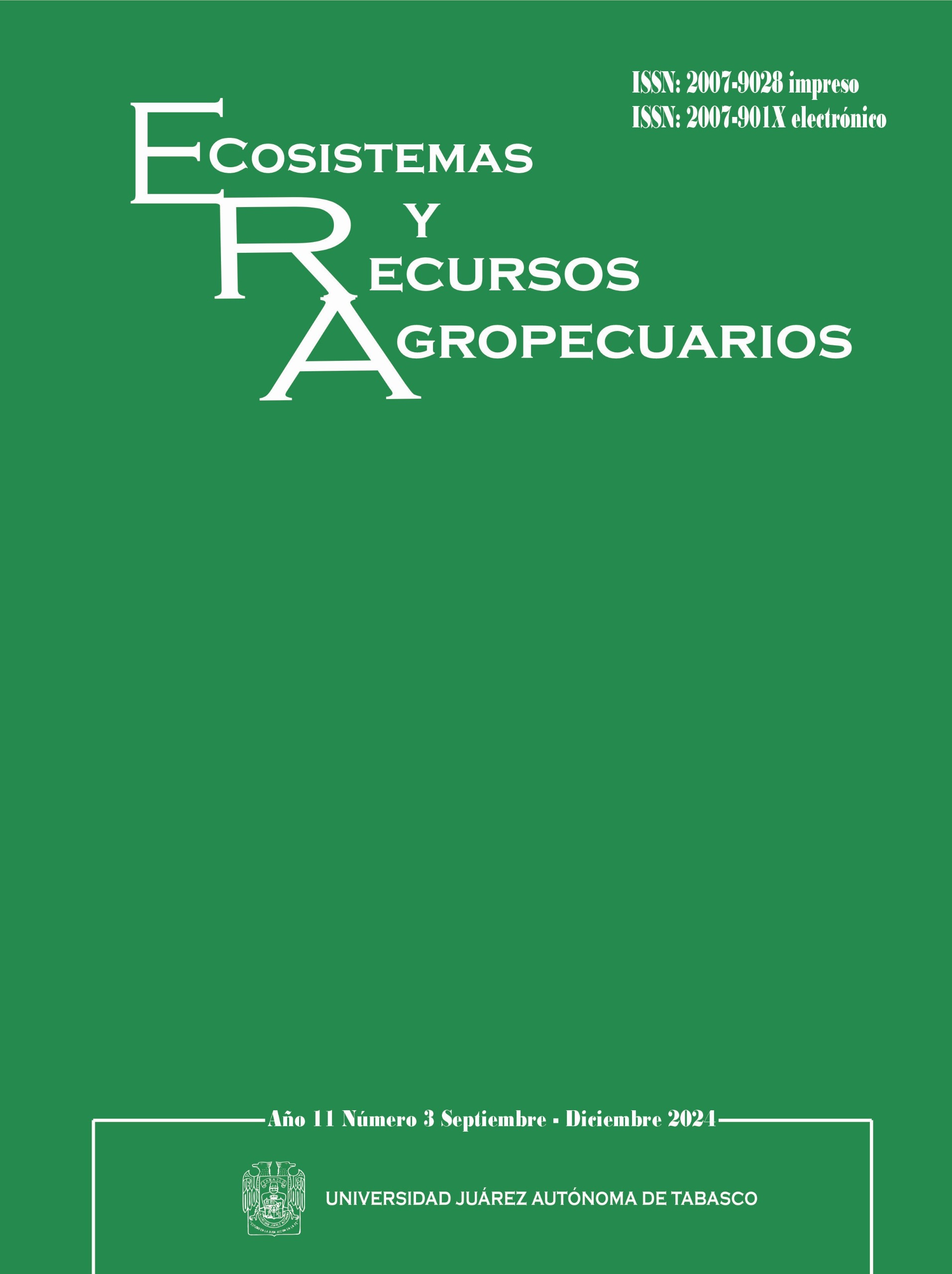Biostimulants of semidesert plants in the root and aerial growth of tomato seedlings
DOI:
https://doi.org/10.19136/era.a11n3.4145Keywords:
Polyphenol extracts, Rhus virens, R. muelleri, Jatropha dioica, Junglans mollisAbstract
Biostimulants are a new sustainable alternative to promote the growth and development of vigorous seedlings in the greenhouse. In the present research, the objective was to evaluate extracts from three semi-desert plants as biostimulants, in the root and aerial growth of seedlings of two varieties of tomato, saladette (Río Grande) and ball (Beef Bang F1), in vitro evaluations were carried out and under greenhouse. The in vitro evaluation was done with the purpose of selecting the extracts that would be used in the greenhouse stage. In vitro, plant extracts from: Rhus muelleri (RM), R. virens (RV), Jatropha dioica (JD) and Juglans mollis(JM) were evaluated at three concentrations each, 75, 100 and 200 mg L-1 and two commercial controls: rooters Rootex (RT) and Raizal (RZ) and an absolute control, without extract or rooters (TC). The total length of the radicle and plumule and the fresh weight of the seedling were evaluated. In the greenhouse, it was first evaluated in a seedbed and then in a pot, the extracts were: RV, RM, JD and RJ, in concentrations of 75 and 200 mg L-1 and the same controls. In both stages, diameter and length of root and stem, fresh and dry weight of root and stem, were evaluated. The extracts of RM 200 and JD 75 had greater stimulation than the commercial rooters, in the root and aerial growth of the seedlings of the two tomato varieties, in vitro, in seedbed and in pots, after transplanting.
Downloads
References
Amaya‐Chantaca D, Flores‐Gallegos AC, Iliná A, Aguilar CN, Sepúlveda‐Torre L, Ascacio‐Valdés JA, Chávez‐González ML (2022) Comparative extraction study of grape pomace bioactive compounds by submerged and solid‐state fermentation. Journal of Chemical Technology & Biotechnology 97(6): 1494-1505. https://doi.org/10.1002/jctb.6977
Arysta Life Science (2024). Hoja Técnica. https://mx.uplonline.com/download_links/HMFxeOexw1QWDfPxLfGlxaOeeSer8F5a1MayGcS9.pdf. Fecha de consulta: 10 de febrero de 2024
Barone V, Baglieri A, Stevanato P, Broccanello C, Bertoldo G, Bertaggia M, Cagnin M, Pizzeghello D, Moliterni VMC, Mandolino G, Fornasier F, Squartini A, Nardi S, Concheri G (2018) Root morphological and molecular responses induced by microalgae extracts in sugar beet (Beta vulgaris L.). Journal of Applied Phycology 30: 1061-1071. https://doi.org/10.1007/s10811-017-1283-3
Bautista-Hernández I, Aguilar CN, Martínez-Ávila GC, Ilina A, Torres-León C, Verma DK, Chávez-González ML (2022) Phenolic compounds and antioxidant activity of Lippia graveolens Kunth residual leaves fermented by two filamentous fungal strains in solid-state process. Food and Bioproducts Processing 136: 24-35. https://doi.org/10.1016/j.fbp.2022.09.001
Bhardwaj RD, Anupam-Sharma AS, Himanshu-Sharma HS, Puja-Srivastava PS (2015) Role of gallic acid pre-treatment in inducing the antioxidant response of two wheat cultivars differing in drought tolerance. Indian Journal of Agricultural Biochemistry 28(2): 155-165. https://doi.org/10.5958/0974-4479.2015.00010.6
Brown P, Saa S (2015) Biostimulants in agriculture. Frontiers in Plant Science 6: 1-3. https://doi.org/10.3389/fpls.2015.00671
Cáceres-Rodríguez JL, Machado-López E, Martínez-López DA, Cortés-Gómez MC, Balaguera- López HE (2022) Rol de los brasinoesteroides en frutales con énfasis en condiciones de estrés abiótico. Ciencia y Agricultura 19(3): 1-16. https://orcid.org/0000-0003-2504-6331
Campobenedetto C, Mannino G, Beekwilder J, Contartese V, Karlova R, Bertea CM (2021) The application of a biostimulant based on tannins affects root architecture and improves tolerance to salinity in tomato plants. Scientific Reports 11(1): 1-15. https://doi.org/10.1038/s41598-020-79770-5
Cerny TA, Rajapakse NC, Rieck JR (2004) Height con¬trol of vegetable seedlings by greenhouse light manipula¬tion. Journal of Vegetable Crop Production 10(1): 67-80. https://doi.org/10.1300/J068v10n01_08
Cosmocel (2024) Hoja técnica. https://www.agrozar.com/files/personalizacion/agrozar/190021/190021-ficha-tecnica.pdf. Fecha de consulta: 10 de febrero de 2024.
Cuesta G, Mondaca E (2014) Efecto de un biorregulador a base de auxinas sobre el crecimiento de plantines de tomate. Revista Chapingo. Serie Horticultura 20(2): 215-222. https://doi.org/10.5154/r.rchsh.2014.01.001
De la Rosa L A, Vazquez-Flores AA, Alvarez-Parrilla E, Rodrigo-García J, Medina-Campos ON, Ávila-Nava A, Gonzalez-Reyes S, Pedraza-Chaverri J (2014) Content of major classes of polyphenolic compounds, antioxidant, antiproliferative, and cell protective activity of pecan crude extracts and their fractions. Journal of Functional Foods 7: 219-228. https://doi.org/10.1016/j.jff.2014.02.008
Du Jardin P (2015) Plant biostimulants: Definition, concept, main categories and regulation. Scientia Horticulturae 196: 3-14. https://doi.org/10.1016/j.scienta.2015.09.021
Espitia-Hernández P, Ruelas-Chacón X, Chávez-González ML, Ascacio-Valdés JA, Flores-Naveda A, Sepúlveda-Torre L (2022) Solid-state fermentation of Sorghum by Aspergillus oryzae and Aspergillus niger: Effects on tannin content, phenolic profile, and antioxidant activity. Foods 11(19): 1-15. https://doi.org/10.3390/foods11193121
Georgé S, Brat P, Alter P, Amiot M J (2005) Rapid determination of polyphenols and vitamin C in plant-derived products. Journal of Agricultural and Food Chemistry 53(5): 1370-1373. https://doi.org/10.1021/jf048396b
Godlewska K, Biesiada A, Michalak I, Pacyga P (2019) The effect of plant-derived biostimulants on white head cabbage seedlings grown under controlled conditions. Sustainability 11(19): 1-30. https://doi.org/10.3390/su11195317
Godlewska K, Biesiada A, Michalak I, Pacyga P (2020) The effect of botanical extracts obtained through ultrasound-assisted extraction on white head cabbage (Brassica oleracea L. var. capitata L.) seedlings grown under controlled conditions. Sustainability 12(5): 1-31. https://doi.org/10.3390/su12051871
Jasso de Rodríguez D, Trejo-González FA, Rodríguez-García R, Díaz-Jiménez MLV, Sáenz-Galindo A, Hernández-Castillo FD, Villarreal-Quintanilla JA, Peña-Ramos FM (2015) Antifungal activity in vitro of Rhus muelleri against Fusarium oxysporum f. sp. Lycopersici. Industrial Crops and Products 75: 150-158 https://doi.org/10.1016/j.indcrop.2015.05.048
Jasso de Rodríguez D, Cuevas CF., Rodríguez-García R., Ramírez H., Díaz-Jiménez L., Villarreal-Quintanilla J, Juárez-Maldonado A (2020) Extractos de plantas del semidesierto en la inducción del crecimiento de tomate (Lycopersicon esculentum Mill). Ecosistemas y Recursos Agropecuarios 7: 1-10. https://doi.org/10.19136/era.a7nl.2342.
Jasso de Rodríguez, D, Rocha-Rivera MF, Ramírez-Rodríguez H, Villarreal-Quintanilla JÁ, Díaz-Jiménez L V, Rodríguez-García R, Carrillo-Lomelí DA (2023) Extractos de plantas como bioestimulantes de crecimiento, rendimiento y calidad de fruto en pimiento morrón. Ecosistemas y Recursos Agropecuarios 10(2): 1-12. https://doi.org/10.19136/era.a10n2.3559
Kubalt K (2016) The role of phenolic compounds in plant resistance. Biotechnology and Food Sciences 80 (2): 97-108 https://doi.org/10.34658/bfs.2016.80.2.97-108
Lazcano-Bello MI, Sandoval-Castro E, Tornero-Campante MA, Hernández-Hernández BN, Ocampo-Fletes I, Díaz-Ruíz R (2021) Evaluación de sustratos, solución nutritiva y enraizador en producción de plántulas de jitomate. Revista Mexicana de Ciencias Agrícolas 12(1): 61-76. https://doi.org/10.29312/remexca.v12i1.2450
Opiyo SA, Njoroge PW, Ndirangu EG, Kuria KM (2021) A review of biological activities and phytochemistry of Rhus species. American Journal of Chemistry 11(2): 28-36 https://doi.10.5923/j.chemistry.20211102.02
Parađiković N, Teklić T, Zeljković S, Lisjak M, Špoljarević M. (2019) Biostimulants research in some horticultural plant species-A review. Food and Energy Security 8(2): 1-12. https://doi.org/10.1002/fes3.162
Ramírez H, Hoad GV, Benavides A, Rangel E (2001) Gibberellins in apple seeds and the transport of [3H]-GA4 Journal of the Mexican Chemical Society 45: 47-50.
Ramírez-Moreno A, Delgadillo-Guzmán D, Bautista-Robles V, Marszalek JE, Keita H, Kourouma A, Ramírez-García SG, Rodríguez-Amado JR, Tavares-Carvalho JC (2020). Jatropha dioica, an Aztec plant with promising pharmacological properties: A systematic review. African Journal of Pharmacy and Pharmacology 14(6): 169-178. https://doi.org/10.5897/AJPP2020.5147
Rodríguez de Luna SL, Ramírez-Garza RE, Serna-Saldívar SO (2020) Environmentally friendly methods for flavonoid extraction from plant material: Impact of their operating conditions on yield and antioxidant properties. The Scientific World Journal 2020: 1-38. https://doi.org/10.1155/2020/6792069
Rouphael Y, Colla G (2020) Biostimulants in agriculture. Frontiers in Plant Science 11: 1-7. https://doi.org/10.3389/fpls.2020.00040
SADER (2023) Chile, cebolla y jitomate, el tricolor de las fiestas patrias: Agricultura. Secretaría de Agricultura y Desarrollo Rural https://www.gob.mx/agricultura/prensa/chile-cebolla-y-jitomate-el-tricolor-de-las-fiestas-patrias-agricultura. Fecha de consulta: 05 de febrero de 2024.
SAS (2013) Base SAS® 9.4 Procedures Guide: Statistical Procedures. Second edition. SAS Institute Inc. Cary, NC, USA. 550p.
SIAP (2023) Panorama Agroalimentario 2023. Servicio de Información Agroalimentaria y Pesquera.
https://drive.google.com/file/d/1FWHntHMgjw_uOse_MsOF9jZQDAm_FOD9/view. Fecha de consulta: 05 de febrero de 2024
Sayed EG, Mahmoud AW M, Abdel-Wahab A, El-Bahbohy RM, Azoz S N (2022) Rootstock priming with shikimic acid and Streptomyces griseus for growth, productivity, physio-biochemical, and anatomical characterisation of tomato grown under cold stress. Plants: 11(21): 1-23. https://doi.org/10.3390/plants11212822
Sharma A, Shahzad B, Rehman A, Bhardwaj R, Landi M, Zheng B (2019) Response of phenylpropanoid pathway and the role of polyphenols in plants under abiotic stress. Molecules 24(13): 2452. https://doi.10.3390/molecules24132452
Singh A, Gupta R, Pandey R (2017) Exogenous application of rutin and gallic acid regulate antioxidants and alleviate reactive oxygen-generation in Oryza sativa L. Physiology and Molecular Biology of Plants 23: 301-309. https://doi.org/10.1007/s12298-017-0430-2
Steiner AA (1961) A Universal Method for Preparing Nutrient Solutions of a Certain Desired Composition. Plant and Soil 15: 134-154.
Tanase C, Nișca A, Mirica A, Milan A, Boz I (2019a) Wood bark as valuable raw material for compounds with a bioregulator effect in lemon balm (Melissa officinalis L.) plants. Applied Sciences 9(15): 1-10. https://doi.org/10.3390/app9153148
Tanase C, Bujor OC, Popa VI (2019b) Phenolic natural compounds and their influence on physiological processes in plants. In: Ross-Watson R (ed). Polyphenols in plants. Academic Press. USA. pp. 45-58. https://doi.org/10.1016/B978-0-12-813768-0.00003-7
Torres-Moreno H, López-Romero JC, Vázquez-Solorio JY, Velázquez-Contreras CA, Garibay-Escobar A, Díaz-López R, Robles-Zepeda RE (2019) Antioxidant, anti-inflammatory and antiproliferative properties of Ibervillea sonorae. South African Journal of Botany 125: 207-213. https://doi.org/10.1016/j.sajb.2019.07.029
Zeljković SB, Parađiković NA, Babić TS, Đurić GD, Oljača RM, Vinković TM, Tkalec MB (2010) Influence of biostimulant and substrate volume on root growth and development of scarlet sage (Salvia splendens L.) transplants. Journal of Agricultural Sciences (Belgrade) 55(1): 29-36. https://doi.org/10.2298/JAS1001029Z
Zuzunaga-Rosas J, González-Orenga S, Tofei AM, Boscaiu M, Moreno-Ramón H, Ibáñez-Asensio S, Vicente O (2022) Effect of a biostimulant based on polyphenols and glycine betaine on tomato plants’ responses to salt stress. Agronomy 12(9): 2142. https://doi.org/10.3390/agronomy12092142
Downloads
Published
Issue
Section
License
Copyright (c) 2024 Ecosistemas y Recursos Agropecuarios

This work is licensed under a Creative Commons Attribution-NonCommercial-ShareAlike 4.0 International License.
Aviso de copyright
Los autores que se envían a esta revista aceptan los siguientes términos:
una. Los autores conservan los derechos de autor y garantizan a la revista el derecho a ser la primera publicación del trabajo con una licencia de atribución de Creative Commons que permite a otros compartir el trabajo con un reconocimiento de la autoría del trabajo y la publicación inicial en esta revista.
B. Los autores pueden establecer acuerdos complementarios separados para la distribución no exclusiva de la versión del trabajo publicado en la revista (por ejemplo, en un repositorio institucional o publicarlo en un libro), con un reconocimiento de su publicación inicial en esta revista.
C. Se permite y se anima a los autores a difundir su trabajo electrónicamente (por ejemplo, en repositorios institucionales o en su propio sitio web) antes y durante el proceso de envío, ya que puede conducir a intercambios productivos, así como a una cita más temprana y más extensa del trabajo publicado. (Consulte El efecto del acceso abierto).


